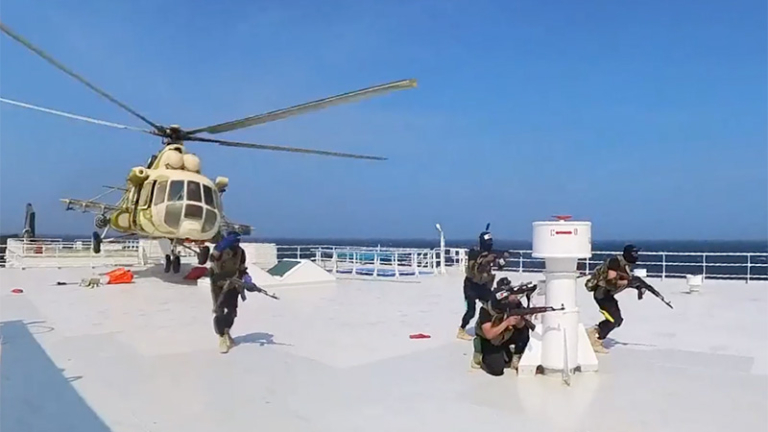
On November 19, Yemen’s Houthis hijacked a cargo ship indirectly linked to Israel as it was traveling in the Red Sea. Much like their firing of missiles toward Israel’s Eilat in October, the rebel group’s ship seizure was a symbolic act declaring that it is throwing its lot in with Hezbollah and Hamas to stop Israel’s war on Gaza. That the ship, named the Galaxy Leader, is neither Israeli-owned nor operated diminishes the likelihood of an immediate Israeli or US military response. But the incident is still a potentially escalatory step toward a broader regional war. Thus far, the possibility of said regionwide conflict depends more on developments on the Lebanese-Israeli border and Iran’s reactions to them than on symbolic Houthi attacks on shipping lanes in the Red Sea or ineffective targeting of Israeli or American facilities in the region.
The Houthi takeover of the Galaxy Leader appeared, in a video the group issued, to be more like a training exercise than an act of war. The ship, flying the Bahamas flag and operated by a Japanese company, has only an indirect Israeli connection (an Israeli businessman holds stocks in the British company that owns the vessel). While condemning the hijacking as “an act of Iranian terror,” the Israeli government also was quick to deny any connection to the vessel, indicating that it had no interest in responding to the seizure. The Houthis in turn issued a statement claiming that the detained crew would be treated “according to our Islamic values.” On November 27, a second cargo ship was seized off the coast of Aden but in this case a US naval vessel intervened and apprehended the attackers, who the Pentagon claimed were likely Somali pirates but have not yet been definitively identified.
Are the Houthis an Iranian Proxy?
The Houthis lead a movement based in the Zaydi Shia sect that once ruled Yemen under the Imamate but that was pushed back to the country’s northern mountainous region after the 1962 republican revolution. In the early 2000s the Houthis forged the Ansar Allah movement, a homegrown political and militant organization principally opposed to the then-central government in Sanaa. In reaction to the 2003 US invasion of Iraq, Ansar Allah adopted the anti-American and anti-Israeli slogan that includes the phrase “death to America, death to Israel.” During their 2004-2010 rebellion against Sanaa, however, the Houthis took no action against Americans and the US Embassy in Sanaa continued to function normally until it was closed in 2015. On the other hand, in 2021, the Houthis breached the embassy compound and detained some of the remaining Yemeni staff guarding it.
Houthis are often described by their opponents as proxies of Iran; Israeli Prime Minister Benjamin Netanyahu has ascribed to Iran the Houthis’ recent firing of rockets toward Israel as well as the seizure of vessels. There was no evidence of Iranian involvement when the Houthis’ rebellion against Sanaa started in 2004, but a relationship with Iran was underway by 2009. Specifically, some Iranian arms reportedly made their way into northern Yemen after Saudi Arabia started assisting the Sanaa government. The Houthis’ relationship with Iran grew closer in 2015 after the Saudi-led Arab military coalition launched its war in Yemen against the group, which had taken over the Yemeni capital in 2014. Still, the Iran-Houthi ties remained nuanced both ideologically and in operational terms. As the Saudi-led war intensified, however, the Houthis’ collaboration with Hezbollah grew, although the Houthis developed their own weapons industry and their own smuggling routes, putting together missile parts that arrived clandestinely from Iran and through the black market. As their integration into the Iran-sponsored network deepened, the Houthis returned the favor to Tehran by funneling Iranian arms to Hamas in Gaza via a chain of smugglers from the Horn of Africa, Sudan, and Egypt.
The prospect of the Houthis coordinating with Hezbollah grows more compelling the longer the conflict lasts.
In recent years Iran, directly and through Hezbollah intermediaries, gradually increased its assistance to the Houthis. Ansar Allah leader Abdel-Malek al-Houthi looks up to Hezbollah’s Secretary-General Hassan Nasrallah and tries to fashion his movement after the Lebanese group. Hezbollah’s assistance has drawn the Houthis closer into a network of pro-Iran non-state actors in the region. Nasrallah’s rhetoric on “the axis of resistance” has been adopted by his Yemeni counterpart to the point where the Houthis now consider themselves an integral part of the axis and in total support of its goals. While the Houthis do not appear to have decided on their degree of involvement in Israel’s war on Gaza, the prospect of coordinating with Hezbollah grows more compelling the longer the conflict lasts.
The Houthis and Hamas
During their 2004-2010 rebellion against Sanaa, the Houthis rarely mentioned Israel or Hamas in their statements or speeches. This was also the case with Hamas, which maintained offices in Sanaa throughout that period and was closer to the Sanaa authorities than to the Houthis. Yemen’s president at the time, Ali Abdullah Saleh, maintained close relations with both Hamas and the Palestinian Authority and in 2007 even offered to mediate the conflict between the two that had erupted after the 2006 Palestinian elections, won by Hamas. President Saleh’s nephew Yahya Saleh founded the Canaan Society, a cultural association that sponsored fundraising and events in support of Palestine and worked closely with Hamas representatives in Sanaa.
Prior to the 2011 Arab Uprisings that led to President Saleh’s 2012 ouster from power, the Ansar Allah movement was focused on domestic Yemeni issues and showed little interest in regional and Palestinian affairs. After the Houthis took over Sanaa in 2014, and especially after the Saudi-led coalition launched its war in Yemen in 2015, the group’s statements on Israel and the United States took on a harsher tone. The Houthis’ relations with Hamas also became much friendlier as their closeness to Hezbollah developed.
The Houthis’ action so far has been limited to giving Israel more fronts to worry about.
During the current Israeli war on Gaza, Houthi statements have expressed unbridled backing for the Palestinians and pledged full support. In line with Hezbollah’s position, however, the Houthis’ action so far has been limited to giving Israel more fronts to worry about and threatening further action should Israel’s attack on Gaza continue. The Houthis have not yet put all-out war on the table. In fact, when reports of a ceasefire emerged, Houthi spokesman Mohamed Abdusalam stated on X (formerly Twitter) that the movement “support[s] any steps taken by the Palestinian resistance and what they see as appropriate in achieving their legitimate goals.”
That said, if the current truce between Israel and Hamas does not hold and military strikes and counter strikes continue to escalate between Israel and Hezbollah and other pro-Iran actors across the Lebanese-Israeli border, an all-out regional war could break out. In such a scenario, the Houthis are likely to be drawn into full involvement, although their contribution to the war effort would probably remain focused on the maritime dimension in the Red Sea, through which they could pose a serious risk to civilian shipping and other naval targets.
US and Israeli Involvement
The Biden administration, which pledged full support to the Israeli government at the start of the war, has deployed two aircraft carrier groups—the USS Gerald R. Ford to the Mediterranean Sea and the USS Dwight D. Eisenhower to the Red Sea—but so far has carefully avoided direct military involvement. The US military has responded defensively and proportionately when attacked inside Iraq and Syria and US reaction to missile launches from Yemen was described as defensive by a Defense Department spokesperson who said the missiles were close enough to the US fleet to justify an interception, indicating that the United States is not interested in getting involved in the skirmishes surrounding the war on Gaza.
The US Navy has conducted close surveillance of Red Sea shipping lanes since the Houthis started targeting Saudi vessels during the Yemen civil war.
Although it is seeking to maintain a cautious ambiguity in the current Israel-Gaza war, the US Navy has conducted close surveillance of Red Sea shipping lanes at least since the Houthis started targeting Saudi naval vessels during its 2015-2023 war with the Saudi-led coalition. The United States stepped up naval deployments even before the October 7 Gaza war to deter Iranian threats against international shipping. No US administration can remain indifferent to any blockage or serious harassment of shipping through the vital Red Sea lanes.
Israel reacted to the Houthi missiles by deploying naval vessels from Eilat but has yet to engage the Houthis directly, a stance that has prompted criticism from Netanyahu’s opposition. In fact, Israeli naval deployments have been increasing since the 2020 Abraham Accords created new security collaborations between Israel and Bahrain and the United Arab Emirates (UAE), as demonstrated by November 20 joint naval maneuvers in the Red Sea involving the navies of these countries and the United States. These exercises were viewed as deterring a confrontation with Iran, but they also could be used against military threats from the Houthis in the Gulf of Aden and the Red Sea.
Looking Ahead
Iran’s direct entry into the war would be a game changer, including by potentially drawing in the United States directly. While the Houthis are capable of obstructing Red Sea shipping lanes, Iran has the ability to block the Strait of Hormuz, a move that would have immediate global repercussions and therefore would pose grave risks to US interests. An Iranian decision to take such a step would be a measure that the Islamic Republic likely would take only if it came under direct attack itself. It is safe to assume that direct involvement by Iran would draw in its allied non-state actors in the region, including the Houthis.
For the time being, the war remains an Israeli-Palestinian one, with Hezbollah and the Houthis playing a supporting role from Lebanon and Yemen. But by design or by incremental escalatory steps that get out of control, the situation could become a regional conflict with the full involvement of the Lebanese and Yemeni fronts. It is impossible to predict how complicated and destructive such a regional war would be, or what would trigger it. Yemen, like Lebanon, is internally divided over the wisdom of getting involved in the Gaza war. Yemen’s UAE-backed Southern Transitional Council, which seeks to be part of a regional alliance against the Houthis, issued an official statement criticizing Ansar Allah’s hijacking of the Galaxy Leader. Yemen’s internationally recognized government, the Saudi-backed Presidential Leadership Council, also criticized the hijacking of ships off Yemen’s coast, calling such acts “maritime piracy.” Indeed, the Gaza war is already drawing in Yemen and exacerbating its internal tensions in the process.
Still, the Houthis’ attacks on Israel, in the form of drone and missile sorties against Eilat, hijacking ships, and verbal denunciations by their spokesmen in Sanaa, are symbolic in nature and effect. They originate in considerations of solidarity with the Palestinians, historical antagonism toward Israel and the United States, and coordination with other factions in the Iran-led axis of resistance, especially Hezbollah. But it is unlikely that the Houthis’ actions alone would lead to widening the war in Gaza to a regionwide conflagration involving Israel, the United States, and Iran and its proxy forces around the Middle East.
The views expressed in this publication are the author’s own and do not necessarily reflect the position of Arab Center Washington DC, its staff, or its Board of Directors

